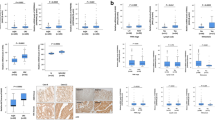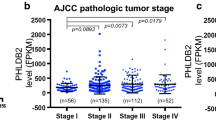Abstract
Hairy enhancer of split-1 (HES1) is a transcriptional target of the Notch pathway, and a high level of HES1 is regarded as a marker of activated Notch. The aim of the study was to investigate the role of HES1 in colorectal cancer progression. We used tissue microarrays to analyze the expression and clinical significance of HES1 in 320 colorectal cancer samples. Stable overexpression and knockdown of HES1 were established in three colorectal cancer cell (CRC) lines (RKO, HCT8 and LOVO). We investigated the differentially expressed genes and enriched pathways in HES1 overexpressing CRC cells by gene expression profiling. Also, the role of HES1 in invasion and migration were examined in vitro and in vivo. We found that high expression of HES1 was significantly correlated with distal metastasis (P = 0.037) at diagnosis, and HES1 could serve as an unfavorable prognostic factor for colorectal cancer patients (P = 0.034). Gene expression profiling and pathway enrichment analysis revealed that HES1 was related to cellular adherens junction loss. In addition, we showed that HES1 overexpression lead to depressed E-cadherin, and elevated N-cadherin, vimentin and Twist-1 levels. Functionally, HES1 enhanced invasiveness and metastasis of CRC cells. HES1 promotes cancer metastasis via inducing epithelial mesenchymal transition and serves as a poor prognosis factor of colorectal cancer patients.




Similar content being viewed by others
References
Jemal A, Bray F, Center MM et al (2011) Global cancer statistics. CA Cancer J Clin 61(2):69–90. doi:10.3322/caac.20107
Bengtsson G, Carlsson G, Hafstrom L et al (1981) Natural history of patients with untreated liver metastases from colorectal cancer. Am J Surg 141(5):586–589
Brenner H, Bouvier AM, Foschi R et al (2012) Progress in colorectal cancer survival in Europe from the late 1980s to the early 21st century: the EUROCARE study. Int J Cancer 131(7):1649–1658. doi:10.1002/ijc.26192
Artavanis-Tsakonas S, Rand MD, Lake RJ (1999) Notch signaling: cell fate control and signal integration in development. Science 284(5415):770–776
Wang Z, Li Y, Banerjee S et al (2009) Emerging role of Notch in stem cells and cancer. Cancer Lett 279(1):8–12. doi:10.1016/j.canlet.2008.09.030
Radtke F, Raj K (2003) The role of Notch in tumorigenesis: oncogene or tumour suppressor? Nat Rev Cancer 3(10):756–767. doi:10.1038/nrc1186
Kageyama R, Ohtsuka T, Kobayashi T (2007) The Hes gene family: repressors and oscillators that orchestrate embryogenesis. Development 134(7):1243–1251. doi:10.1242/dev.000786
Sang L, Roberts JM, Coller HA (2010) Hijacking HES1: how tumors co-opt the anti-differentiation strategies of quiescent cells. Trends Mol Med 16(1):17–26. doi:10.1016/j.molmed.2009.11.001
Ramskold D, Luo S, Wang YC et al (2012) Full-length mRNA-seq from single-cell levels of RNA and individual circulating tumor cells. Nat Biotechnol 30(8):777–782. doi:10.1038/nbt.2282
Zhang P, Yang Y, Zweidler-McKay PA et al (2008) Critical role of notch signaling in osteosarcoma invasion and metastasis. Clin Cancer Res 14(10):2962–2969. doi:10.1158/1078-0432.CCR-07-1992
Zhang P, Yang Y, Nolo R et al (2010) Regulation of NOTCH signaling by reciprocal inhibition of HES1 and Deltex 1 and its role in osteosarcoma invasiveness. Oncogene 29(20):2916–2926. doi:10.1038/onc.2010.62
Fan X, Mikolaenko I, Elhassan I et al (2004) Notch1 and notch2 have opposite effects on embryonal brain tumor growth. Cancer Res 64(21):7787–7793. doi:10.1158/0008-5472.CAN-04-1446
Wang X, Fu Y, Chen X et al (2010) The expressions of bHLH gene HES1 and HES5 in advanced ovarian serous adenocarcinomas and their prognostic significance: a retrospective clinical study. J Cancer Res Clin Oncol 136(7):989–996. doi:10.1007/s00432-009-0744-8
Kinzler KW, Nilbert MC, Su LK et al (1991) Identification of FAP locus genes from chromosome 5q21. Science 253(5020):661–665
Reedijk M, Odorcic S, Zhang H et al (2008) Activation of Notch signaling in human colon adenocarcinoma. Int J Oncol 33(6):1223–1229
Veenendaal LM, Kranenburg O, Smakman N et al (2008) Differential Notch and TGFbeta signaling in primary colorectal tumors and their corresponding metastases. Cell Oncol 30(1):1–11
Meng RD, Shelton CC, Li YM et al (2009) gamma-Secretase inhibitors abrogate oxaliplatin-induced activation of the Notch-1 signaling pathway in colon cancer cells resulting in enhanced chemosensitivity. Cancer Res 69(2):573–582. doi:10.1158/0008-5472.CAN-08-2088
Gao F, Zhang Y, Wang S et al (2014) Hes1 is involved in the self-renewal and tumourigenicity of stem-like cancer cells in colon cancer. Sci Rep 4:3963. doi:10.1038/srep03963
Ingram WJ, McCue KI, Tran TH et al (2008) Sonic Hedgehog regulates Hes1 through a novel mechanism that is independent of canonical Notch pathway signalling. Oncogene 27(10):1489–1500. doi:10.1038/sj.onc.1210767
Stockhausen MT, Sjolund J, Axelson H (2005) Regulation of the Notch target gene Hes-1 by TGFalpha induced Ras/MAPK signaling in human neuroblastoma cells. Exp Cell Res 310(1):218–228. doi:10.1016/j.yexcr.2005.07.011
Curry CL, Reed LL, Golde TE et al (2005) Gamma secretase inhibitor blocks Notch activation and induces apoptosis in Kaposi’s sarcoma tumor cells. Oncogene 24(42):6333–6344. doi:10.1038/sj.onc.1208783
Wu XR, He XS, Chen YF et al (2012) High expression of CD73 as a poor prognostic biomarker in human colorectal cancer. J Surg Oncol 106(2):130–137. doi:10.1002/jso.23056
Rhodes DR, Yu J, Shanker K et al (2004) ONCOMINE: a cancer microarray database and integrated data-mining platform. Neoplasia 6(1):1–6
Yu X, Alder JK, Chun JH et al (2006) HES1 inhibits cycling of hematopoietic progenitor cells via DNA binding. Stem Cells 24(4):876–888. doi:10.1634/stemcells.2005-0598
Adams JC (2004) Roles of fascin in cell adhesion and motility. Curr Opin Cell Biol 16(5):590–596. doi:10.1016/j.ceb.2004.07.009
Lokeshwar VB, Cerwinka WH, Isoyama T et al (2005) HYAL1 hyaluronidase in prostate cancer: a tumor promoter and suppressor. Cancer Res 65(17):7782–7789. doi:10.1158/0008-5472.CAN-05-1022
Turner CE (2000) Paxillin and focal adhesion signalling. Nat Cell Biol 2(12):E231–E236. doi:10.1038/35046659
Qiao L, Wong BC (2009) Role of Notch signaling in colorectal cancer. Carcinogenesis 30(12):1979–1986. doi:10.1093/carcin/bgp236
Candy PA, Phillips MR, Redfern AD et al (2013) Notch-induced transcription factors are predictive of survival and 5-fluorouracil response in colorectal cancer patients. Br J Cancer 109(4):1023–1030. doi:10.1038/bjc.2013.431
Rhodes DR, Kalyana-Sundaram S, Mahavisno V et al (2007) Oncomine 3.0: genes, pathways, and networks in a collection of 18,000 cancer gene expression profiles. Neoplasia 9(2):166–180
Wang Z, Banerjee S, Li Y et al (2006) Down-regulation of notch-1 inhibits invasion by inactivation of nuclear factor-kappaB, vascular endothelial growth factor, and matrix metalloproteinase-9 in pancreatic cancer cells. Cancer Res 66(5):2778–2784. doi:10.1158/0008-5472.CAN-05-4281
Balint K, Xiao M, Pinnix CC et al (2005) Activation of Notch1 signaling is required for beta-catenin-mediated human primary melanoma progression. J Clin Invest 115(11):3166–3176. doi:10.1172/JCI25001
Bennani-Baiti IM, Aryee DN, Ban J et al (2011) Notch signalling is off and is uncoupled from HES1 expression in Ewing’s sarcoma. J Pathol 225(3):353–363. doi:10.1002/path.2966
Thiery JP, Sleeman JP (2006) Complex networks orchestrate epithelial-mesenchymal transitions. Nat Rev Mol Cell Biol 7(2):131–142. doi:10.1038/nrm1835
Sonoshita M, Aoki M, Fuwa H et al (2011) Suppression of colon cancer metastasis by Aes through inhibition of Notch signaling. Cancer Cell 19(1):125–137. doi:10.1016/j.ccr.2010.11.008
Kang Y, Massague J (2004) Epithelial-mesenchymal transitions: twist in development and metastasis. Cell 118(3):277–279. doi:10.1016/j.cell.2004.07.011
Grunert S, Jechlinger M, Beug H (2003) Diverse cellular and molecular mechanisms contribute to epithelial plasticity and metastasis. Nat Rev Mol Cell Biol 4(8):657–665. doi:10.1038/nrm1175
Sahlgren C, Gustafsson MV, Jin S et al (2008) Notch signaling mediates hypoxia-induced tumor cell migration and invasion. Proc Natl Acad Sci USA 105(17):6392–6397. doi:10.1073/pnas.0802047105
Becker KF, Rosivatz E, Blechschmidt K et al (2007) Analysis of the E-cadherin repressor Snail in primary human cancers. Cells Tissues Organs 185(1–3):204–212. doi:10.1159/000101321
Niessen K, Fu Y, Chang L et al (2008) Slug is a direct Notch target required for initiation of cardiac cushion cellularization. J Cell Biol 182(2):315–325. doi:10.1083/jcb.200710067
Mani SA, Guo W, Liao MJ et al (2008) The epithelial-mesenchymal transition generates cells with properties of stem cells. Cell 133(4):704–715. doi:10.1016/j.cell.2008.03.027
Hanahan D, Weinberg RA (2011) Hallmarks of cancer: the next generation. Cell 144(5):646–674. doi:10.1016/j.cell.2011.02.013
Moon CM, Kwon JH, Kim JS et al (2014) Nonsteroidal anti-inflammatory drugs suppress cancer stem cells via inhibiting PTGS2 (cyclooxygenase 2) and NOTCH/HES1 and activating PPARG in colorectal cancer. Int J Cancer 134(3):519–529. doi:10.1002/ijc.28381
Acknowledgments
Supported by National Natural Science Foundation of China (Nos. 81072046, 91029702, 81402019), 985 project of Sun Yat-sen University, Guangdong Translational Medicine Public Platform (4202037), and Guangdong Department of Science & Technology Translational Medicine Center Grant (2011A080300002). We thank Bart Westendorp kindly for revision of the manuscript.
Conflict of interest
The authors declare that they have no conflict of interest.
Author information
Authors and Affiliations
Corresponding author
Additional information
Ruixue Yuan, Jia Ke and Lei Sun have contributed equally to this work.
Rights and permissions
About this article
Cite this article
Yuan, R., Ke, J., Sun, L. et al. HES1 promotes metastasis and predicts poor survival in patients with colorectal cancer. Clin Exp Metastasis 32, 169–179 (2015). https://doi.org/10.1007/s10585-015-9700-y
Received:
Accepted:
Published:
Issue Date:
DOI: https://doi.org/10.1007/s10585-015-9700-y




